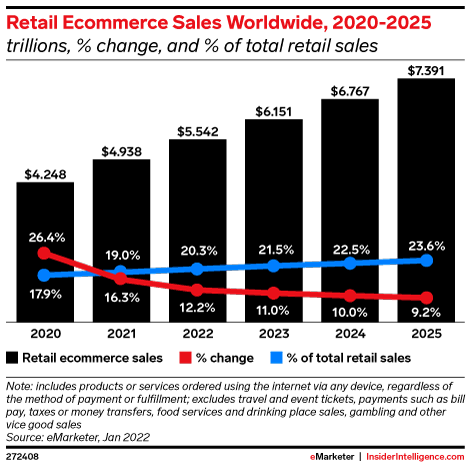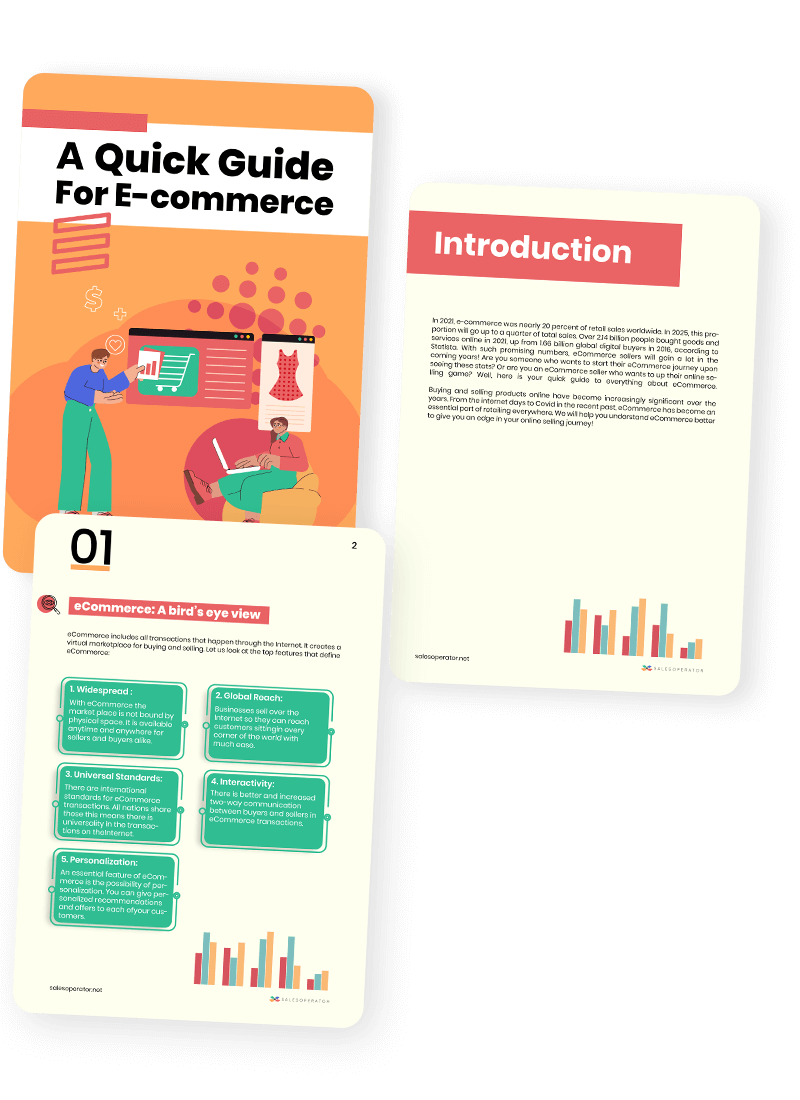Online shopping, virtual events, and live streaming have recently seen significant global shifts. Customers have been experimenting with new technology. On the other hand, businesses struggle to stand out from the crowd. This is because of the competition, made fierce by social media algorithms.
Some businesses use multi-channel selling to expand their brand’s visibility, boost revenues, and attract new clients for their online store. Maintaining a consistent brand presence across various online and offline media is crucial for businesses nowadays. However, a lot of companies aren’t making the most of it.
Multichannel retailers today must be quick to adapt and act regarding the “how”, “when”, “where”, and even the “why” of selling on different channels.
Multi-channel selling
Multi-channel selling helps in reaching out to as many prospective customers as possible. These sales channels often include offline stores, online retail stores, large and niche markets, online auctions, etc.
You may have read about some of the advantages of multi-channel selling. What if we tell you that there is more to it? Although it might seem like a simple marketing strategy, there is much to learn about how multi-channel selling works.
According to figures from 2021, almost 19% of all retail sales were made online. And this trend is here to stay! Per projections, this upward tendency will continue, rising as high as 22% by 2024. The trick is to use this trend to your advantage to gain maximum profit. But this will happen only if you are knowledgeable and experienced.

You will surely lose out on a lot of potential sales if you do not use multi-channel selling. That’s what we are here for: to assist you in getting started! We will thoroughly explain what multi-channel selling is and what it can accomplish for you.
Why Use Multi-channel Selling Techniques?
1. Marketplaces are important for eCommerce businesses
If we look around, we notice that brands frequently have a presence online on:
- Own website
- Social media
- Marketplaces (Amazon, eBay, etc.)
A 2018 consumer survey reveals that rather than Google, almost half (46.7%) of all “product searches” take place directly on marketplaces like Amazon. That is a sizable portion of all searches. Then isn’t it almost a given that you must have a presence in these marketplaces?
Would you be able to think of more than 5 that you can list right now? Many of us most likely won’t. Instead of attempting to figure out where to sell, wouldn’t it be better to concentrate on the actual “selling”? That’s why the goal of SalesOperator is to provide you with a multichannel eCommerce solution so that you can give more time and pay attention to selling your products.
2. Increases conversion rates and brand awareness
According to US Census research, retail sales for online retailers grow at 1.5 percent annually. And this has been the trend for the past five years. This represents a significant increase in overall sales.
What happens once you have listed your products on these marketplaces? There will be increased exposure to more and more prospective clients. As more people become aware of your brand, there will be an increase in conversions to sales. This seems a strong reason to join the bandwagon.
3. Using social media to promote products
A typical user is on various social media apps for at least an hour daily. The major social media platforms have benefited from these consumer habits. They introduced functions like shoppable pins and Instagram and Facebook shopping. With this, most customers can buy things without leaving the social media website.
According to a Global World Index study, 37% of consumers look for products on social media. The majority of purchases are then done directly through social media. It only makes sense that you would use social media as a channel for your target audience.
Multi-channel Selling: Challenges
1. Building a branding strategy
Focusing on the overall website or social media marketing won’t help when developing the branding strategy. A separate branding and messaging plan are required for each channel you have opted for. This requires you to continually stay up to date with the shifting trends of each platform. Each platform will need to reflect these current trends if you wish to send out a promotion.
2. Managing inventory
To meet the growing demand for the products, online sales platforms must be added and, thus, more inventory. Of course, this is a good problem to have. But, it also means you will need to look into:
- Warehouses Locations
- Distribution methods
- Updating inventory
About 55% of eCommerce stores still use inventory management on paper. This is a more tedious and time-consuming option. Utilizing an inventory management system is, hence, advisable.
3. Controlling the customer experience
Everyone knows how important customer satisfaction is to a company’s success. Customers won’t want to return your products without them.
If you’re competitor-focused, you must wait until a competitor is doing something. Being customer-focused allows you to be more pioneering.
Jeff Bezos, CEO of Amazon
Typically, managing the customer experience for a single sales channel is easy. But the game changes drastically when you have more channels to take care of. What you will have to cope with for all your channels includes:
- Streamlining the messaging process
- Identifying pain points
- Managing refunds and complaints
The Best Ways to Use Your Multi-Channel Selling Strategy
It’s exciting to learn about all the advantages a multi-channel selling approach may offer your company. You might be prepared to start right away and bite the bullet. But first, let’s go through some tactics you might want to keep in mind.
1. Choose sales channels that are right for YOU
There are numerous options within multichannel eCommerce. Each multi-channel selling channel has unique advantages and disadvantages that may impact your organization. Needs that are specific to you must be considered.
For instance, one of the top eCommerce platforms in the Amazon marketplace. If your brand is marketed as a premium good, Amazon might not help cater to your specific target market. In such a case, selling in specialized online stores might be better. Consider this: You wouldn’t buy a Gucci purse on Amazon, would you?
The most popular internet sales channels are listed below for your use:
- Social media platform – Instagram
- Handmade marketplace – Etsy
- Auction-based marketplace – eBay
- General marketplace – Amazon
- Unique marketplace – Rebels Market
- Niche marketplace – ASOS
- Subscription marketplace – YoKart
- Daily deals – TravelZoo
- Classified listings – GumTree
- Comparison marketing – Pricegrabber
2. Integrate all your inventory for easier management
As a retail seller, you have a lot to do to keep your business going, such as handling the finances, the merchandise, and the employees. However, all of these problems are readily resolved with little forethought. There are systems in place for these.
Managing inventory for each of your merchants is one of the main challenges of being a multichannel merchant. The amount of time you would have to spend keeping an eye on each platform’s inventory levels is enormous. And managing inventories isn’t exactly simple. You must manage many constantly changing numbers for each of your merchants. That certainly sounds like a formula for trouble down the road.
Therefore, your responsibility is to set up inventory management before that happens. Setting up a system to integrate all of your inventory on one platform is advisable before you start multi-channel selling. You’ll have a clearer notion of your overall inventory after doing this. Additionally, there will be significantly fewer chances of mistakes and miscalculations.
3. Centralize all your multichannel data
Would you agree that having a single dashboard for your sales data makes more sense than managing several dashboards?
From this one dashboard, you will be able to:
- Upload all of your products so that they are reflected in each channel
- Remove the items you no longer sell from all of your channels.
- Establish a buying cap to prevent running out of supplies.
- Automatically sync orders to reduce overall inventory and record sales.
- View a complete, in-depth report of all your sales and inventory data.
Therefore, centralizing all of your data can assist you in making better judgments that are based on information from the real workings of all your platforms.
Summary
Being a multichannel merchant has its advantages and disadvantages, just like any other selling technique. With a strong plan and efficient use of software to operate your business, the challenges of multi-channel selling can be effectively tackled.
You should remember that multi-channel selling and marketing is more than just listing your products on as many sales channels as possible. It would be best if you considered a variety of issues. This covers messaging, inventory management, deliverability, and brand positioning. Plan out all these aspects well in advance instead of seeking for marketplaces to sell your goods right away.
Hence, in conclusion: Choose the appropriate sales channels. Utilize tools and software to centralize your data and organize your inventory. This is how you can avoid issues in the future and become a successful multi-channel eCommerce seller!




